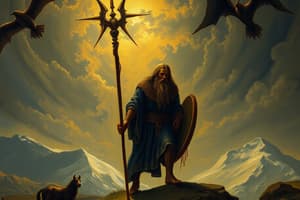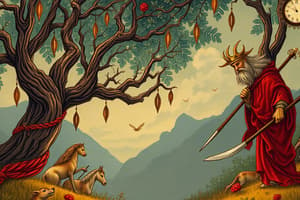Podcast
Questions and Answers
Which characteristic is most indicative of Old English literature?
Which characteristic is most indicative of Old English literature?
- Oral transmission and heroic themes. (correct)
- Dominance of prose and essays.
- Focus on courtly love and chivalry.
- Exploration of complex ideas through metaphors.
Which of the following events had the most significant impact on English literature during the Medieval Period?
Which of the following events had the most significant impact on English literature during the Medieval Period?
- The Protestant Reformation
- The invention of the printing press
- The voyages of exploration to the New World
- The Norman Conquest (correct)
What is the primary narrative structure employed in Geoffrey Chaucer's The Canterbury Tales?
What is the primary narrative structure employed in Geoffrey Chaucer's The Canterbury Tales?
- A single, continuous epic poem
- A series of letters exchanged between characters
- A collection of interconnected stories told by pilgrims (correct)
- A dramatic play with multiple acts and scenes
Which of the following best characterizes the focus of Renaissance literature?
Which of the following best characterizes the focus of Renaissance literature?
What distinguishes metaphysical poetry from other poetic styles of the 17th century?
What distinguishes metaphysical poetry from other poetic styles of the 17th century?
How did the King James Bible influence the English language and literature?
How did the King James Bible influence the English language and literature?
Which themes are most commonly explored in Shakespearean tragedies such as Hamlet and Macbeth?
Which themes are most commonly explored in Shakespearean tragedies such as Hamlet and Macbeth?
What political and social context primarily shaped 17th-century English literature?
What political and social context primarily shaped 17th-century English literature?
Which literary period is characterized by an emphasis on reason, logic, and order?
Which literary period is characterized by an emphasis on reason, logic, and order?
Which event directly influenced the themes and styles of writing during the Interregnum?
Which event directly influenced the themes and styles of writing during the Interregnum?
In the context of literary periods, what is the significance of Wordsworth and Coleridge's Lyrical Ballads (1798)?
In the context of literary periods, what is the significance of Wordsworth and Coleridge's Lyrical Ballads (1798)?
Which literary period saw the rise of the novel as a dominant form of literature?
Which literary period saw the rise of the novel as a dominant form of literature?
Which author is best known for novels depicting social problems during the Victorian era, such as poverty and inequality?
Which author is best known for novels depicting social problems during the Victorian era, such as poverty and inequality?
What is a defining characteristic of Modernist literature that distinguishes it from earlier periods?
What is a defining characteristic of Modernist literature that distinguishes it from earlier periods?
Which literary period is associated with skepticism, irony, and the blurring of lines between high and low culture?
Which literary period is associated with skepticism, irony, and the blurring of lines between high and low culture?
What themes are commonly explored in Postcolonial literature?
What themes are commonly explored in Postcolonial literature?
Which of the following authors is known for satirical critiques of human nature and society?
Which of the following authors is known for satirical critiques of human nature and society?
During which period did the Pre-Raphaelite Brotherhood, known for combining Romantic and medieval influences, emerge?
During which period did the Pre-Raphaelite Brotherhood, known for combining Romantic and medieval influences, emerge?
Flashcards
English Literature
English Literature
Body of written works in the English language, spanning poetry, prose, drama, and literary criticism from Anglo-Saxon times to today.
Anglo-Saxon Period
Anglo-Saxon Period
The period from approximately 450-1066 AD, characterized by heroic poems and religious texts.
Beowulf
Beowulf
An epic poem from the Anglo-Saxon period about a Geatish hero battling monsters.
Medieval Period
Medieval Period
Signup and view all the flashcards
The Canterbury Tales
The Canterbury Tales
Signup and view all the flashcards
Renaissance
Renaissance
Signup and view all the flashcards
William Shakespeare
William Shakespeare
Signup and view all the flashcards
Paradise Lost
Paradise Lost
Signup and view all the flashcards
The Enlightenment (18th Century)
The Enlightenment (18th Century)
Signup and view all the flashcards
Robinson Crusoe
Robinson Crusoe
Signup and view all the flashcards
Gulliver's Travels
Gulliver's Travels
Signup and view all the flashcards
Romantic Period
Romantic Period
Signup and view all the flashcards
Lyrical Ballads (1798)
Lyrical Ballads (1798)
Signup and view all the flashcards
Frankenstein
Frankenstein
Signup and view all the flashcards
Victorian Period
Victorian Period
Signup and view all the flashcards
Charles Dickens
Charles Dickens
Signup and view all the flashcards
Modern Period
Modern Period
Signup and view all the flashcards
The Waste Land
The Waste Land
Signup and view all the flashcards
Study Notes
- English literature encompasses a vast body of written works produced in the English language.
- It includes diverse genres such as poetry, prose, drama, and literary criticism.
- English literature spans from the Anglo-Saxon period to the present day, reflecting social, political, and cultural shifts.
Anglo-Saxon Period (c. 450-1066)
- Old English literature is characterized by heroic poems, elegies, and religious texts.
- Beowulf is the most famous work from this period.
- It's an epic poem that tells the story of a Geatish hero who battles monsters.
- Other notable works include The Wanderer, The Seafarer, and the writings of Cædmon and Cynewulf.
- Literature was orally transmitted before being written down.
Medieval Period (1066-1485)
- The Norman Conquest in 1066 significantly influenced English literature, introducing French language and culture.
- Geoffrey Chaucer's The Canterbury Tales is a landmark work.
- It is a collection of stories told by pilgrims on their way to Canterbury Cathedral.
- Medieval romances, such as Sir Gawaine and the Green Knight, were popular.
- These stories often involved knights, chivalry, and courtly love.
- Religious writings and moral allegories, like Piers Plowman by William Langland, were also prominent.
- The works of Julian of Norwich, a mystic, provide insight into medieval religious thought.
Renaissance (c. 1485-1660)
- The Renaissance saw a renewed interest in classical learning and a flourishing of the arts and literature.
- William Shakespeare is considered the greatest writer in the English language.
- His plays, including Hamlet, Macbeth, Romeo and Juliet, and Othello, explore universal themes of love, ambition, and revenge.
- Elizabethan poetry, including sonnets by Shakespeare, Edmund Spenser, and Sir Philip Sidney, was highly refined.
- Christopher Marlowe, Ben Jonson, and John Donne were other significant playwrights and poets of the era.
- The King James Bible, published in 1611, had a profound impact on the English language and literature.
17th Century (1600-1700)
- The 17th century was marked by political and religious upheaval, reflected in its literature.
- The metaphysical poets, including John Donne, George Herbert, and Andrew Marvell, explored complex ideas through elaborate metaphors and conceits.
- John Milton's Paradise Lost is an epic poem that retells the story of the Fall of Man.
- Prose writing, including the essays of Francis Bacon and the sermons of John Donne, became increasingly important.
- The English Civil War and the Interregnum influenced the themes and styles of writing.
18th Century (1700-1800)
- The 18th century, also known as the Enlightenment or the Age of Reason, emphasized reason, logic, and order.
- The rise of the novel is a key development in this period.
- Daniel Defoe's Robinson Crusoe and Samuel Richardson's Pamela are early examples of the novel form.
- Jonathan Swift's Gulliver's Travels is a satirical critique of human nature and society.
- Poets like Alexander Pope and John Dryden wrote in a formal, neoclassical style.
- The periodical essay, exemplified by The Spectator and The Tatler, was a popular form of social and moral commentary.
Romantic Period (c. 1785-1832)
- The Romantic period emphasized emotion, imagination, and individualism.
- William Wordsworth and Samuel Taylor Coleridge's Lyrical Ballads (1798) is considered the starting point of the Romantic movement.
- Other major Romantic poets include Lord Byron, Percy Bysshe Shelley, and John Keats.
- Romantic novels, such as Mary Shelley's Frankenstein and Walter Scott's historical romances, explored themes of nature, the supernatural, and the past.
- Jane Austen, while often considered separate, wrote during this time, offering social commentary through novels like Pride and Prejudice and Emma.
Victorian Period (1837-1901)
- The Victorian period was marked by rapid industrialization, social change, and the expansion of the British Empire.
- Charles Dickens is the most famous Victorian novelist.
- His works, including Oliver Twist, Great Expectations, and A Tale of Two Cities, depict the social problems of the era.
- Other notable Victorian novelists include the Brontë sisters (Charlotte, Emily, and Anne), George Eliot, and Thomas Hardy.
- Victorian poetry includes the works of Alfred, Lord Tennyson, Robert Browning, and Elizabeth Barrett Browning.
- The Pre-Raphaelite Brotherhood, including Dante Gabriel Rossetti and Christina Rossetti, combined Romantic and medieval influences in their art and poetry.
Modern Period (1901-1945)
- The Modern period was characterized by experimentation, fragmentation, and a sense of disillusionment following World War I.
- Modernist writers sought to break away from traditional forms and explore new ways of representing reality.
- Key modernist novelists include James Joyce, Virginia Woolf, and Joseph Conrad.
- T.S. Eliot's The Waste Land is a landmark poem of the modernist era.
- Other important modernist poets include W.B. Yeats, Ezra Pound, and Wilfred Owen.
- The interwar period saw the rise of new literary genres, such as the detective novel and the science fiction novel.
Postmodern Period (1945-Present)
- The Postmodern period is characterized by skepticism, irony, and a blurring of the lines between high and low culture.
- Postmodern literature often challenges traditional notions of narrative, character, and meaning.
- Key postmodern novelists include Samuel Beckett, Thomas Pynchon, and Don DeLillo.
- Contemporary poets engage with a wide range of themes and styles.
- Postcolonial literature explores the legacy of colonialism and the experiences of marginalized communities.
- The rise of diverse voices and perspectives has led to a more inclusive and representative literary landscape.
Studying That Suits You
Use AI to generate personalized quizzes and flashcards to suit your learning preferences.
Description
Explore English literature from the Anglo-Saxon to Medieval periods. Discover heroic poems like Beowulf and Chaucer's Canterbury Tales. Trace the influence of historical events and cultural shifts on literary works.




